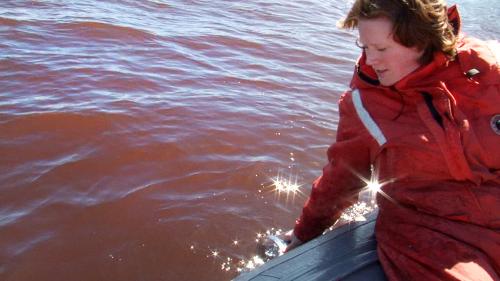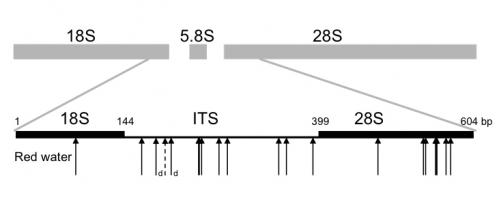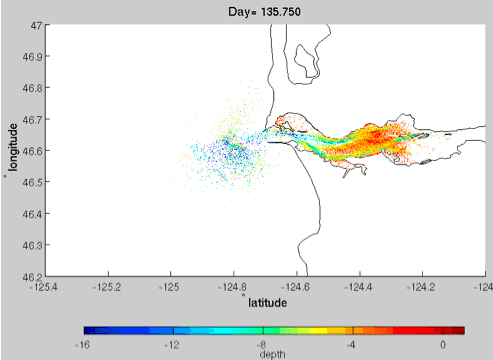You are here
CMOP Scientists Use Multigene Approach to Study Red Water Blooms
09/20/10 Portland, Ore.
 Lydie Herfort collects a sample of red water in the estuary. Watch video.For several decades, massive red tides have been observed in the Columbia River estuary during late summer and early fall. Little scientific information has existed about what triggers red water bloom formation.
Lydie Herfort collects a sample of red water in the estuary. Watch video.For several decades, massive red tides have been observed in the Columbia River estuary during late summer and early fall. Little scientific information has existed about what triggers red water bloom formation.
Scientists at the Center for Coastal Margin Observation & Prediction (CMOP) are delving into the genetics of Myrionecta rubra (M. rubra) that forms these red tides in the Columbia River estuary. Their research findings have been recently accepted in the journal of Aquatic Microbial Ecology.
 Sites of sequence polymorphisms between two variants of M. rubra.
Sites of sequence polymorphisms between two variants of M. rubra.
Enlarge (with full caption) M. rubra is a photosynthetic ciliate that generates large, non-toxic blooms. They contain red colored chloroplasts that originate from cryptophyte algae. The intense red color in the water is a result of high concentrations of M. rubra cells at the surface.
“The ultimate goal of the research is to learn if Myrionecta rubra could be used as a sentinel for environmental change,” says Lydie Herfort, a postdoctoral researcher at Oregon Health & Science University (OHSU) and lead author of the paper.
 Computer simulations are being used to explore hypotheses for the generation of M. rubra blooms.
Computer simulations are being used to explore hypotheses for the generation of M. rubra blooms.
View modeling animation"Researchers typically use higher taxonomic ranked organisms, like salmon, to identify changing conditions in the estuary. But microorganisms react more quickly to environmental change and might be used as an early warning signal. "
Before Herfort and the research team can identify M. rubra as a sentinel, they need to understand how the bloom forms, its dynamics, and the ecological impact on the environment.
Over a three-year period, the team investigated the genetic variability of M. rubra population and their cryptophyte chloroplasts in the Columbia River coastal margin.
Peter Zuber, professor at OHSU and principal investigator of the project says, “the research indicates at least five variants of M. rubra that exist on the Oregon and Washington coast. But only one of the variants leads to blooms in the estuary. We speculate the bloom forming variant is uniquely adapted to the estuarine environment and is highly proliferative, unlike the other variants. “
 Phycoerythrin fluorescence reading from SATURN-01 on August 26, 2010. Red indicates high concentration of M. rubra cells in the water column.The initial results identify a specific association between M. rubra and cryptophyte that leads to blooms. The team used a multigene approach and single-cell genetic analysis to show that the bloom-forming variant of M. rubra appears to harbor the same cryptophyte chloroplast in recurring years.
Phycoerythrin fluorescence reading from SATURN-01 on August 26, 2010. Red indicates high concentration of M. rubra cells in the water column.The initial results identify a specific association between M. rubra and cryptophyte that leads to blooms. The team used a multigene approach and single-cell genetic analysis to show that the bloom-forming variant of M. rubra appears to harbor the same cryptophyte chloroplast in recurring years.
The team is moving forward with the research by adding phycoerythrin fluorescence sensors to SATURN observatory stations. Phycoerythrin is the red pigment in M. rubra. The data from the sensor will give them the ability to continuously monitor M. rubra over long periods of time and continue to learn more about the blooms in the estuary.
Written by Jeff Schilling
###
This research was supported in part through the National Science Foundation cooperative agreement OCE-0424602.
Related Links
Impact of a Myrionecta rubra red tide on the Columbia River estuary. AGU Ocean Sciences Abstract
SATURN Observation Network: Phycoerythrin fluorescence readings at SATURN-01 and SATURN-03






